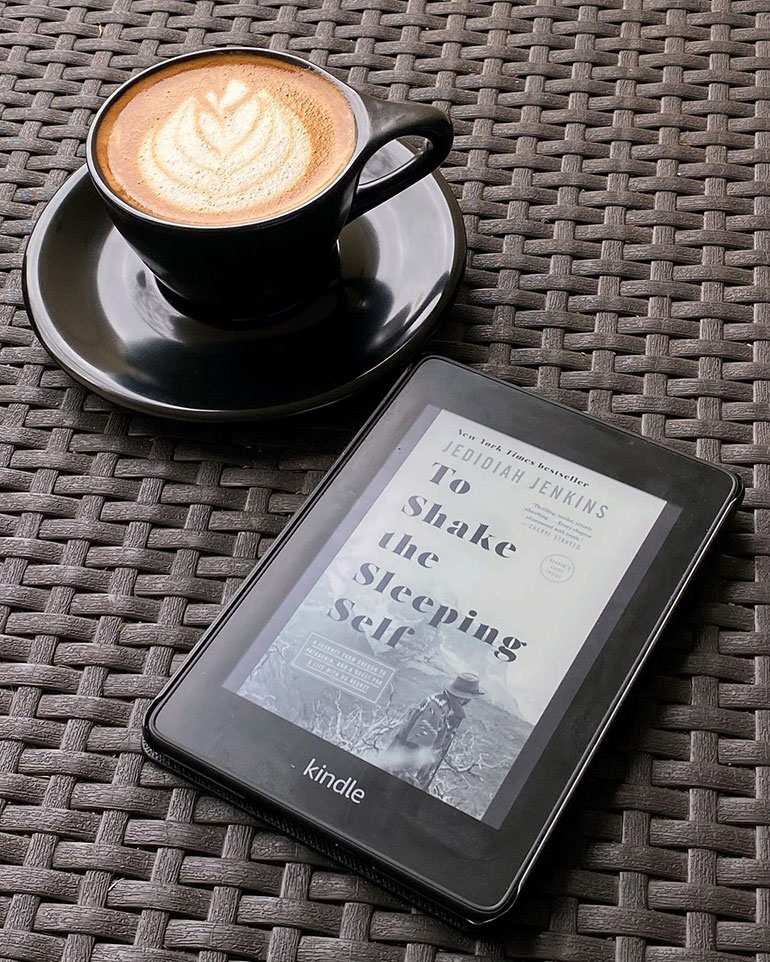Reading List

At the start of the 2020 COVID-19 quarantine my ability to follow wanderlust was immediately curtailed. While I did manage to get a quick trip to North Carolina in January and then Tokyo in February, four more trips were cancelled and then my state shut down nearly four months, I was out of work with a lot of time on my hands.
During this time I chose to dive head first into reading, starting with some books I had bought over the years but never read, then quickly spiraling towards ordering used books weekly online and eventually getting a Kindle. In all, I read over 50 books in 2020, many of them about travel, adventure and wanderlust. In no particular order these are books I’ve enjoyed and recommended to others who miss the adventure of packing a car for a road trip or getting on a plane to some far off land. The brief descriptions are my memories from reading them, not copy and pasted from another site.
My intention is to continuously update this as I have time and finish books.
Book Recommendations:
The Art of Stillness: Adventures in Going Nowhere by Pico Iyer. This short, 92 page book takes 1-2 hours to read and I fell in love with it so much that there’s a recurring reminder on my iPhone to reread it every January 1st to start my year. Pico is a well traveled author with dozens of books to his name, but this book focuses on the journey inward. I’ve gifted this book to several people since first reading it because I believe it’s that insightful.
Travels with Charley in Search of America by John Steinbeck. By the late 1950’s this Nobel Prize winning author had published some of his most amazing work, including Of Mice and Men and, The Grapes of Wrath. He felt disconnected from the country though, from the Americana he had so lovingly been writing about for several decades. In 1960 he bought a brand new GMC pick-up and had it fitted with a small cabin in the truck bed, filled it with everything he’d need including a sleeping bed, typewriter, books and maps to head out on a cross country drive to reconnect with America. This was #vanlife before there was such a term. Charley is his poodle, his companion and his watcher. Having read this book 60 years after it was written shook me to how much things today are the same, for better and worse, and how much has changed. Today, this would be a vlog series on YouTube or documented on Instagram, but Mr. Steinbeck’s amazing ability to tell a story makes this read unbelievably enjoyable.
Seven Years In Tibet by Heinrich Harrer. I was fascinated with the Brad Pitt movie when it came out in 1997 and only loosely had an idea it was based on a true story. The movie has the majority focus on the relationship between Heinrich Harrer and His Holiness, The Dalai Lama. The book on the other hand is more about the struggle Heinrich and his travel companion, Peter endure a near 2-year journey on foot to Tibet. Unbelievable to think this happened just 75ish years ago. The last handful of chapters covers observations and life within Tibet and some of the groundwork about Heinrich’s education of the young leader, through his exile to India.
The Last Season by Eric Blehm. This was a suggestion from a good friend and it’s a captivating, true tale of perhaps one of the most beloved and experienced National Park rangers to ever serve. I’ll leave this review short as to not give any indication where the book goes, but it’s hard to put this one down.
What is the What by Dave Eggers. This came as a recommendation by a client as a must read, but left me with virtually no other backstory. Rather than reading into the book description, I bought it and spent the next week or so reading it. It’s a big book and it’s not an easy read. The story follows a young boy by the name of Valentino Achak Deng in the late 1980’s Sudan in the middle of a violent civil war. Quickly separated from his family during an invasion, he ends up walking with dozens of other young boys for what seems like an eternity, en-route to Ethiopia. Achak (his birth name) is about my age, so this book really pulled on some strings while his journey unfolds, thinking about what I was doing at the age of 8 or 9 compared to what he had to endure. While reading this I kept thinking to myself, this happened just 30ish years ago, how? This isn’t a typical travel book, it is however a reality that someone went through to escape certain death and overcome struggles most westerners could never fathom. The group would later be referred to as The Lost Boys.
To Shake the Sleeping Self: A Journey from Oregon to Patagonia, and a Quest for a Life with No Regret by Jedidiah Jenkins. I have mixed feelings about including this book on here, as I rated it 2 stars. It’s a quick and easy read though and maybe it’s best to come to your own conclusions. The story is about riding a bicycle from Oregon to Patagonia, that’s what hooked me and that’s mostly what the story is about. I wish this book was so much more, in so many ways though, mostly from a technical perspective, but also understand it was ultimately Jedidiah’s journey and not mine. It’s a tad heavy in the religion aspect, be warned if that’s not your thing. One of the more recent adventure books I’ve read, Jedidiah was one of the early influencers on Instagram, before the term was coined.
Greenlights by Matthew McConaughey. While this isn’t a travel or adventure book in the traditional sense, Matthew spent a good number of years living out of an Airstream and randomly went to Africa to find his favorite musician, a journey that took him up a river into places where tourists just don’t go. He’s got a lot of life advice, some witty one-liners and I could hear his Texas accent as I read the entire book. One of my favorite quotes from the book,
We are more constantly bombarded by unnatural stimuli than ever before. We need to put ourselves in places of decreased sensory input so we can hear the background signals of our psychological processes. As the noise decreases, the signals become clearer, we can hear ourselves again, and we reunite. Time alone simplifies the heart.
South: The Story of Shackleton’s Last Expedition, 1914-1917 by Ernest Henry Shackleton. In another one of those this happened only 100 years ago moments, it’s an unbelievable first hand account of being stranded in the oceans below Patagonia, then Elephant Island and then an absolutely absurd rescue attempt. The sheer perseverance of Captain Schackleton and confidence in him by the crew is unparalleled. I’ll preface this recap with, the first two-thirds of the book were amazing, the last portion is a diary regurgitation by the captain of the second boat on the voyage and not nearly as entertaining. There are also a good number of terms and words that aren’t in common use these days, the built in dictionary and Wikipedia of the Kindle really helped out here. Additionally, there are a lot of references to latitude and longitude along with landmarks that weren’t terribly familiar to me, so I did spend time between pages looking things up on Google. Lastly, Shackleton does a wonderful job describing the surroundings but also had an extremely talented photographer on board. A series of photos from the months at sea and being stranded can be found here. The photos help paint a picture between the words that really tied the story in for me.
The Longest Walk: An Odyssey of the Human Spirit by George Meegan. In the mid-1970’s this English Navy vet set out on a goal to do the longest, uninterrupted walk in history. From Ushuaia the capital of Tierra del Fuego at the bottom tip of Argentina he started. 19,019 miles later he ended up in north of the Arctic Circle in Alaska. The journey took 7 years, and the thought is absolutely astounding. This is a big book, 400 pages, but cut down from the 600,000 word manuscript (journal) he kept along the way, chronically his ups and downs, of which there are many. Keep Google Maps open and search the cities he walks through just to get an idea of enormous this feat is.
The Great Railway Bazaar by Paul Theroux. Nearly 50 years ago the American author took a series of train rides from London through Europe, Central Asia, all the way to East Asia, then back via Russia. His goal wasn’t to get somewhere, rather to simply enjoy the time on the train and conversations with strangers, of which there are many. The start of the book didn’t make a lot of sense to me, but as chapters passed I realized the author’s keen sense of people and surroundings, the idiosyncrasy of every day life and is ability to create narration. Like other books written decades ago, keeping Google Maps nearby will help as borders have changes, countries have come and gone and visually it may be hard to picture where he’s at. An interesting twist is when he travels through Vietnam, still at war during the 1973 journey, but fascinating how the locals planned to encourage tourism. Sadly, the return journey home seems to be rushed, or as if the author realized he was already 300 pages deep and couldn’t make this a 700 page book. A favorite quote,
I’ve got a theory that what you hear influences—maybe even determines—what you see. An ordinary street can be transformed by a scream. Or a smell might make a horrible place attractive.
Around The World In 80 Days by Jules Verne is now (in 2022) 150 years old, and is an amazing read for everyone who loves travel and adventure but also has a bit of gamble in them. This purely fictional tale has been made into movies and TV series over and over but the book lets the mind wander a bit more. There are some 19th century words that don’t translate well and some language that is no longer in use, but overall it’s a delightful, quick read.
Desert Solitaire: A Season in the Wilderness by Edward Abbey is a classic for a reason. Admittedly, I started reading this book several years ago and the first chapter or so didn’t really hook me, I put it aside and didn’t pick it up again until very recently. Before reading this book it’s important to understand the context, that it is a chronological story from a man’s time in the 1950’s that he wrote about approximately a decade later, in the 1960’s. Understanding this, and that his time there was just a decade after WWII had ended puts things into context a bit more. The state of the National Parks system was barely 25 years old as he was stationed in Arches National Monument; Later to be Arches National Park. It’s also not just about Edward being alone, he in fact has several adventures, although from the writing it seems they are more about spending time around someone, and not with someone.
One thing mentioned several times is the author’s coined phrase, Arches National Money-Mint and this evolves as he can almost see into the future of the lazy traveler. Again, another book from 70+ years ago that hold so much relevance today, and how we travel, see our country and consume too much. Anyone who has been to Arches, or desires to go should read this.
Ten Years a Nomad: A Traveler’s Journey Home by Matthew Kepnes is an enjoyable read that chronicles how a recent college grad broke off from the rate race, traveled around the world, fell in love and learned about himself as a humble brag to follow up his very well known travel guide, How to Travel the World on $50 a Day: Travel Cheaper, Longer, Smarter. Full disclosure, I haven’t read the latter, was unaware of Matt’s travel blog or of him until this book popped into a suggested list. In a weekend it’s easy to lean back and read this book, but don’t expect travel advice, just use it as inspiration to move [your body, your mindset, your travel plans, etc.].
Matt and I share some similarities, starting off with a trip to Costa Rica, then Thailand, which is fun to read about, but some of this book comes off dated. This is to no fault to Nomadic Matt himself, but when he started out many of the things that help inspire travel and make it easier simply didn’t exist, like an iPhone, Instagram, Uber or even Airbnb (although through his decade in the world, it is mentioned towards the end). I imagine if you’re a fan of his blog or previous books and travel guides this is a great synapses of what really happened during that decade of his life, regardless, this is a solid 3.5 star book for me and one I think is worth reading.
Some of the books I’ve picked up over time came from used bookstores, both locally and while traveling. I will always encourage anyone who is an avid reader to buy used, buy local or use a library first. Many more were purchased used from Better World Books with cheaper prices compared Amazon used and BWB typically offer 25% off 3 book purchases with free shipping. Shipping is slow, be prepared for that. Save $5 off a $30 order at this link.
By summer I had a mini-library growing despite giving away over a dozen books I thought friends would enjoy. The thought of having shelves of books in my home brings me no joy whatsoever, although I do enjoy the smell of new and used books. After weighing some options, reading reviews and watching a few videos I splurged on an 8GB Kindle Paperwhite and ultra thin protective shell with auto wake / sleep cover. With it came a 3 months subscription to Kindle Unlimited which I then abused but did not re-subscribe to. Overall, this small device is easily one of the best purchases I’ve made in a long time and anyone on the fence about purchasing a Kindle, my advice is to just do it.

Something witty will go here
